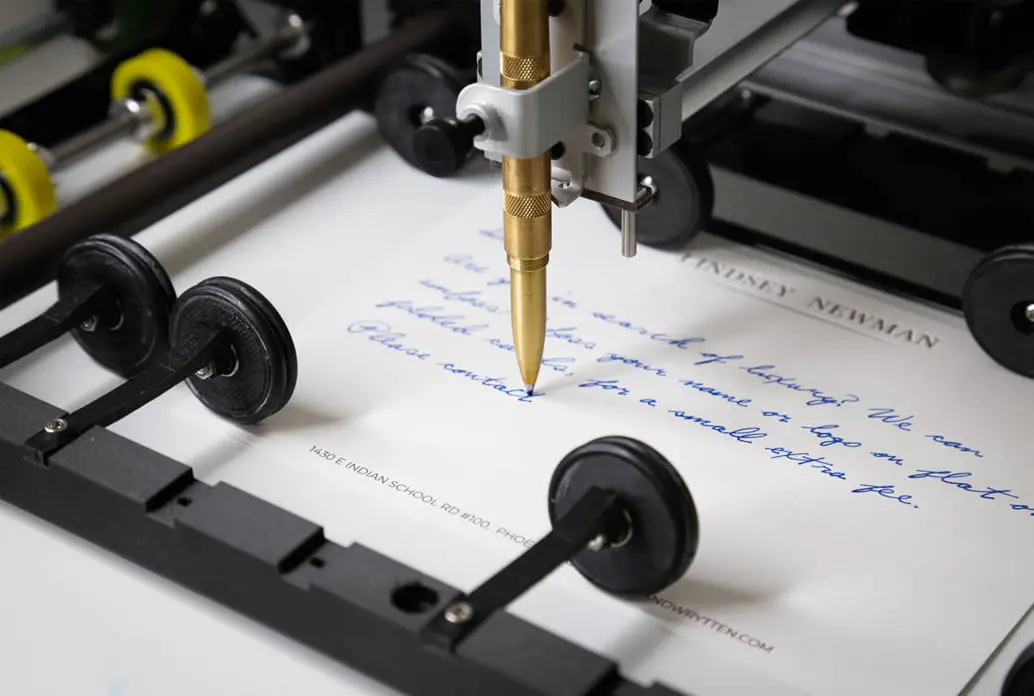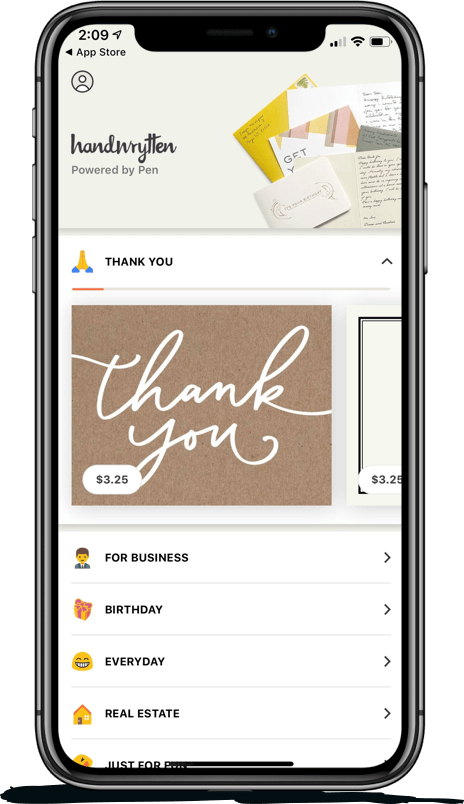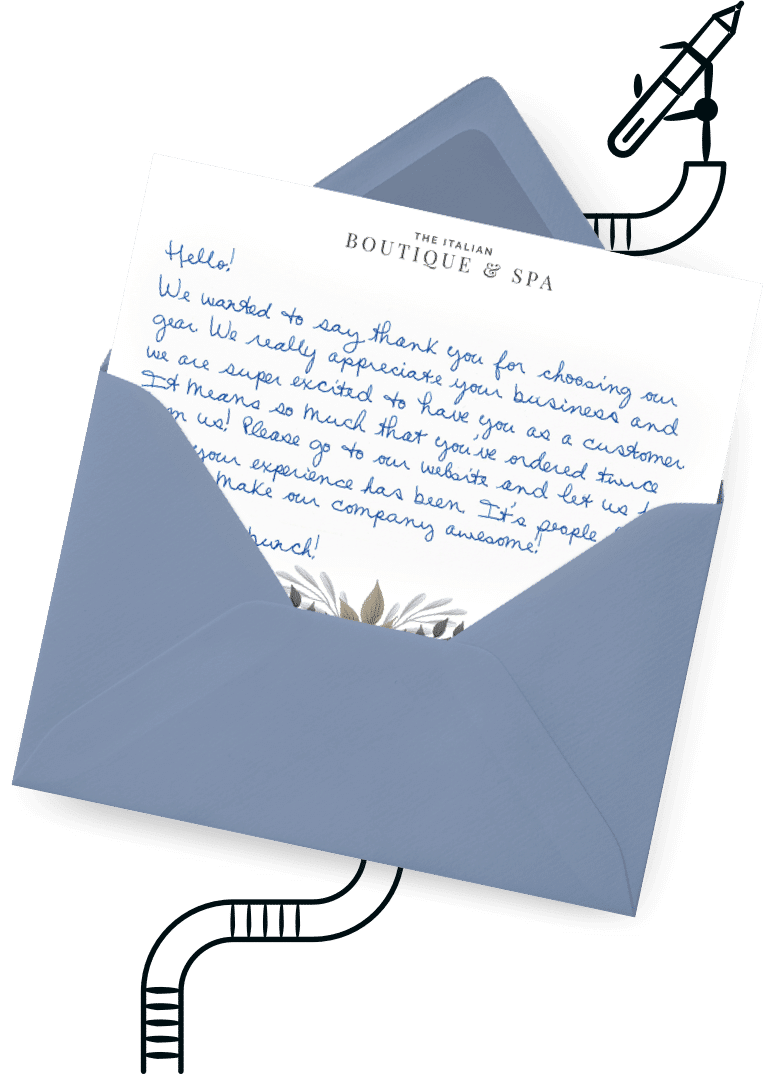
9280 S. Kyrene Rd.
Suite 134
Tempe, AZ 85284
Phone: +1 (888) 284-5197
Email: contact@handwrytten.com



You have been subscribed. Thank you!
We’ve all been there. It’s your boss’s or a co-worker’s birthday, and the greeting card gets passed around the office for everyone to sign. If you don’t know this person well – and are not a natural writer – it can be difficult to come up with the right words to say.
The problem intensifies with a thank-you note. Not only do you need to come up with the words, but you also need to express them with the right combination of humility and gratitude – without sounding ingratiating. Striking that balance is hard for anyone, especially if you don’t know the recipient well.
Stuck on what to write? Need ideas for creativity? Read on for a thank you letter example for all different ways to close and sign off your thank-you notes.
We live in a digital era. Much of our language happens in text form, such as email or social media, which means the standard rules of communication don’t apply. It’s not often you see an email with a proper organization such as a heading and signoff.
Sometimes texting doesn’t even include punctuation, let alone any further formal structure. And social media seems to twist the rules to be whatever kind of expression the poster wants it to be.
In this modern context, it’s easy to lose personality and warmth in the process of communicating. When you show gratitude through writing a note, you can be yourself and show genuine appreciation with a feeling that goes beyond symbols on a page.
A handwritten note is old-fashioned, which appeals to sentimental types – and especially older generations who may not be hip to all the technological developments out there. A text message may be easier, but frankly, thank you notes are unparalleled when it comes to being able to properly express gratitude.
Ultimately, anything that takes effort to accomplish makes it easier for the other party to appreciate the sentiment. As an accompaniment to a thoughtful gift, a handwritten note won’t fail to touch the receiver. The time put into a well written letter shows you care!
If you want to make an impact, consider a meaningful gift, then include with it a handwritten thank-you note on personalized stationery.
Through multiple studies, we’ve seen a strong correlation between a show of gratitude and feelings of happiness. When you tell someone you care about what they did for you, it strengthens your bond, lifts your spirits, and helps put the rest of the world in perspective.
The recipient of your thank-you card isn’t the only one who benefits – you do, too!
Through multiple studies, we’ve seen a strong correlation between a show of sincere gratitude and feelings of happiness. When you tell someone you care about what they did for you, it strengthens your bond, lifts your spirits, and helps put the rest of the world in perspective. We also experience a positive connection to something beyond ourselves.
Whether it be a prayer to a higher being or a simple note handed to a friend, there’s no doubting the power of being thankful.
Part of basic etiquette is showing your thankfulness to others’ thoughtfulness. Regardless of the occasion to write a thank-you card, be assured that sharing your feelings will never be a waste.
You might send thank-you notes after…
You have all the materials needed. You’ve carved out time in your schedule to devote to writing a card. You’re committed and ready to make this thank-you deeply meaningful. You sit down, pen poised… and draw a blank. Now what?
First, think about the structure or shape of the thank you-note you’re about to write. Is it a business letter or a similarly formal letter? Or is it just a stand thank you letter?
Not only does this help you organize your thoughts, but it also lends aesthetic appeal to the note when the recipient first sees it. The way you arrange your words shows thoughtfulness as much as the sentiment held within. We really can’t overstate the effect of a neatly-designed note!
You probably want to begin with a greeting. The standard choice of “Dear [Name]” is classic and safe, but may not be appropriate in all circumstances – for example, if it’s your mother’s birthday, “Happy birthday Mom!” is a much more appropriate opening. In other cases, you could choose something more formal or classy, like “To Whom It May Concern,” but be careful it doesn’t come off sounding stuffy.
Then, launch into the body of the message. This should take up about 1-3 paragraphs. It’s up to you whether to stay polite and reserved or get boldly affectionate. Think about your relationship with the person you’re writing to, and make your judgment accordingly.
You may begin by detailing what they did for you that was so meaningful, then talk about their value to you as a friend/family member/coworker. You could even wrap up your thank-you note with a positive nod to a future engagement – such as the next time you’ll see them in similar circumstances (i.e., “looking forward to meeting when I come to town again”).
Finally, choose a sign-off before signing your name at the bottom. This is the most unique touch, as well as the last thing the recipient reads, so you want to make sure it’s the most special.
Based on the occasion for writing, you may change the signoff to suit your tone. This line can be elegant and professional, affectionate and warm, or a mix of both.
It’s standard – though not required – to leave 2-3 lines in between your signoff and your name. Why? That way, you can give your card one last personalized touch by signing your name instead of leaving just a print version. Feel free to get fancy here – colored ink, loopy lettering, or stay obscure like a doctor’s prescription – whatever expresses you best.
We’ve arranged these in order of formality, beginning with the most stately and morphing into more casual sign-offs. Choose whichever one suits your occasion best.
A standard fallback when you don’t know what else to use, this also keeps some professional distance between you and the card recipient.
Another good choice for a professional situation. Here, you’re not only expressing your gratitude but also wishing positivity in the future. This one may also work for a sympathy card.
If you don’t know someone personally, you don’t need to be effusive in your sign-off. Staying terse here is more apropos – though this word choice still shows your regard for them. This is highly effective in thank you notes post-job interview.
This one shows a deep level of connection with the individual you’re sending the card to. Only use it in cases where you know a person intimately – but if you do use “with love” to end your card, it will almost certainly leave them with a warm feeling.
Another good way to stay optimistic and wish good vibes for the future, but with a bit more warmth. This could work for someone you know a little, such as a co-worker. If you wanted to take it up notch, change it to “warmest wishes”.
Thanks can be elevated to a fancier word, keeping the same sentiment. This one could be perfect in thanking somebody for attending your baby shower, for example.
With a subservient attitude but without going overboard in affection, this phrase has an elegant appeal. Use for a colleague in a supervisory position or an older family member.
It sounds simple – maybe even redundant – but if you haven’t said those two fundamental words elsewhere in your message, they will make a big impact at the end.
This is for a buddy who did something nice for you. Even though your friendship is apparent, stating it in writing gives the phrase a lovely permanence, making it clear that a formal letter is not what your message is meant to be.
More specifically, this one is best saved for someone you know you will be seeing again, particularly in the same context which prompted you to write the note in the first place.
It’s one thing to write a hard copy of a thank-you note. You need to go to the store and pick out the perfect card or stationary, find the right pen, then ensure you don’t damage or smear the card before it makes its way into the recipient’s hands.
A handwritten note, while lovely, comes with its inconveniences. So what if there were an easier way to extend your gratitude, without all that fuss?
Use Handwrytten to inspire your gratitude in thoughtful and artistic ways. Send your thank-you cards online in minutes! The robot technology uses customized handwriting to retain a personal touch, even digitally.
We take care of postage and shipping, too. Handwrytten makes it super easy to send cards online to whoever in your life needs a reminder that they are special – receiving one of these will almost certainly make them feel greatly appreciated.


Scale your handwritten outreach, creating positive impressions and long lasting bond.
Sign Up Today!


Over 100 designs to choose from or design your own. Our online card customizer makes it simple.
Check Out Our Cards!





